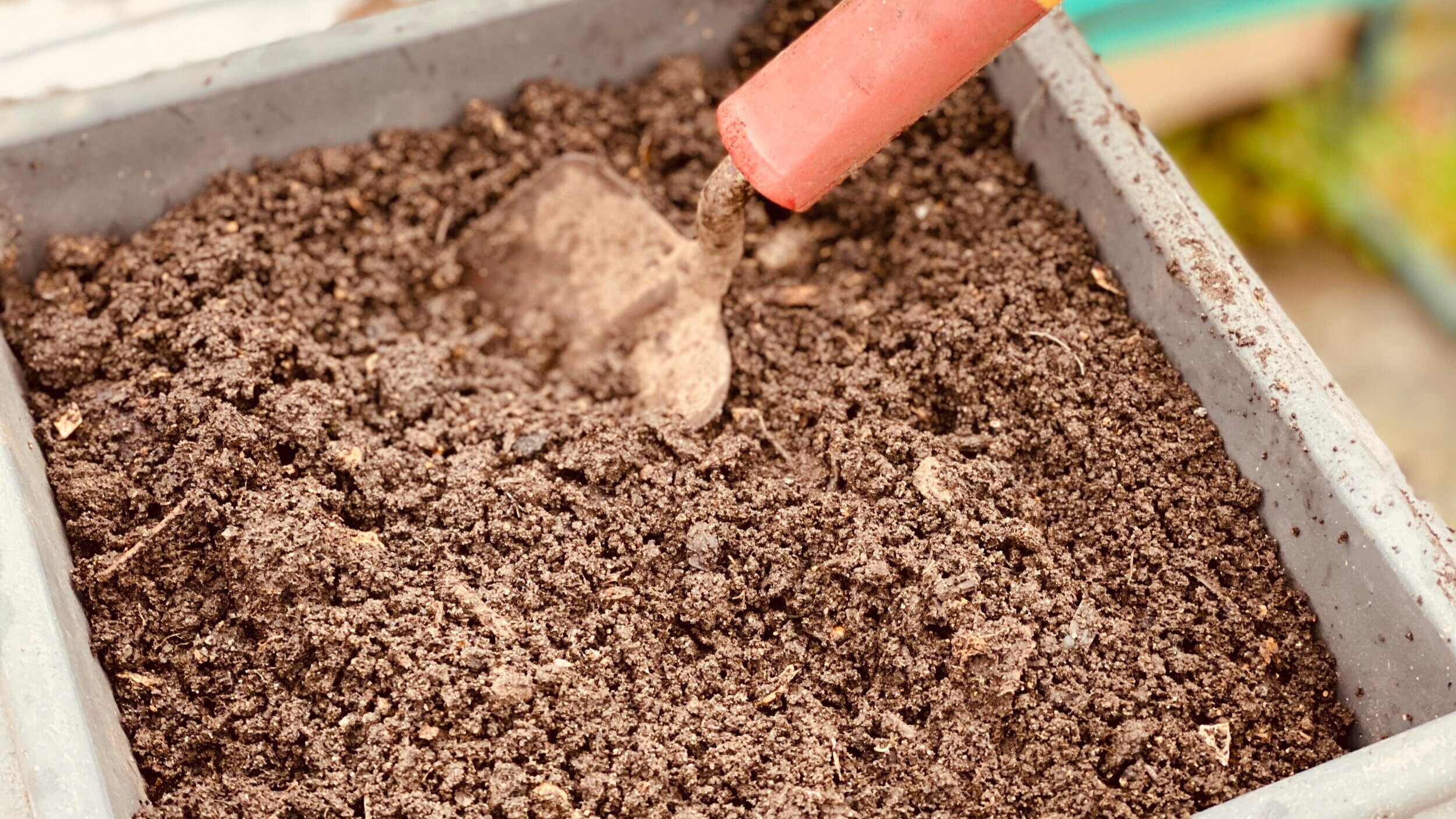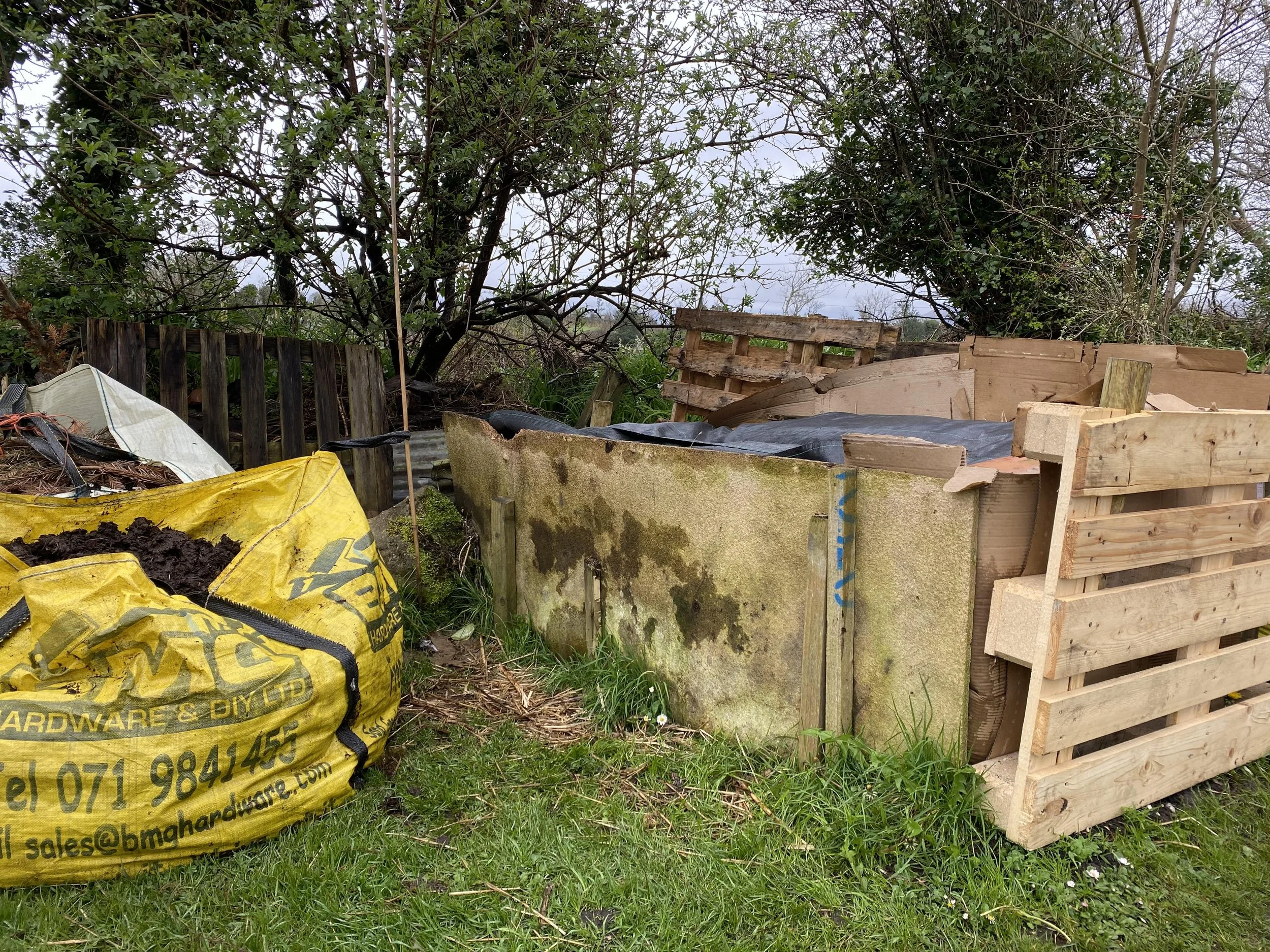“All you need is compost, compost is all soil needs”
Our homemade compost ready to apply!
Composting turns waste material into food for the soil
“Bulky manure costs money and is not always easy to obtain. Home-made compost cost nothing and is also an invaluable source of humus. So however small your garden, if you are growing vegetables make space for a compost heap or bin. You can never have too much comp[ost. It is extraordinary how a huge heap settles into an insignificant pile.” (Joy Larkcom in Grow your own vegetables)
Since our arrival in Ireland in 1985 composting as part of recycling household and garden waste has undergone a dramatic change: From dumping grass clippings and putting kitchen waste into black plastic bags to councils issuing compost bins to households, the arrival of the brown compost bin and the commercial production of compost through recycling of household and council waste.
The benefits of this change for us and the environment are obvious. Materials that can be composted account for as much as half of household waste. By making compost at home, in a community, a school or in an allotment we can not only make a major contribution to waste reduction but more importantly to soil fertility and soil renewal. We gardeners call compost “black gold” and we are proud to produce this ever more important fertiliser following the organic mantra: Feed the soil that feeds the plants that feed us.
Composting and Climate Change
There are many ways we can help to reduce our carbon footprint and combat climate change and sometimes supporting the environment is as simple as composting organic waste. Every time we compost vegetable peels or garden weeds we limit organic matter from impacting on climate change. This easy action can greatly increase the amount of carbon that is stored in the soil. Composting increases the formation of stable carbon that remains bound in the soil for long periods of time and compost applied as organic fertiliser also helps slow down greenhouse emissions in arable soil.
Our health depends on healthy soil
Think about how important prebiotic and probiotic foods are for our gut health, which is vital for our general health. Think about the global soil as the gut or the digestive system of planet Earth and the root ball of plants as their gut. Think how important it is to literally feed the soil with living food that contains a whole range of bacteria and fungi. Think about compost as the best probiotic food for the soil and you get an idea about the close connection between a healthy soil producing highly nutritious food and our health.
What is in a handful of soil?
Good healthy soil is an amazing ecosystem and soil microbial communities are considered the most biodiverse in the world and it is estimated that a single teaspoon of garden soil may contain thousands of species, a billion individuals and one hundred metres of fungal networks. Producing highly nutritious vegetables depends on the ability of the soil to make every nutrient available to the plant. And like all organic growers all over the world I believe that it is best for the health of the soil to be feed with manure and compost and not to have our soil food manipulated by the chemical industry.
Interesting soil fact: Researchers analysing soil from Ireland long thought to have medicinal properties have discovered that it contains a previously unknown strain of bacteria which is effective against four of the top six superbugs that are resistant to antibiotics, including MRSA.
Our compost area does not look very photogenic, but the composting works efficiently and the end product is great. The white bag in the background left contains leaves for leafmould and the yellow bag contains one year old farmyard manure from our neighbour.
Spring is here and it’s the perfect time to start your very own compost
Composting is a natural process requiring little expertise if you just follow these guidelines. So let’s get practical:
Choose the right site
Ideal is a corner in the North East of your garden, but not too far from the house, so it’s easily accessible.
Choose the right container
A wide range of compost containers are available and are best if you are short of space. I prefer open composting and use recycled pallets to build a three-bay container, each bay one meter deep, wide and high. In bay one I collect all the green materials, in bay two all the brown materials and if I have enough I fill bay three with alternate layers of greens and browns; with each layer between 5cm and 10cm thick. A cubic meter is a good size as the compost needs to heat up to ideally 65 Celsius. A good foundation is a layer of small branches or twigs or straw will help aerate and drain it.
Compost the right materials Waste is divided into green and brown materials, depending on its chemical make-up. Green waste is nitrogen rich and includes grass cuttings, vegetable peelings and scraps and young weeds. Comfrey leaves and seaweed can be great additions. Brown waste is carbon rich and includes egg shells, wood ash, coffee grinds, shredded hedge clippings, autumn leaves, old plants, shredded newspaper, cardboard and straw. Chop or shred organic waste so it can decompose faster.
Get the moisture right
It is important that your compost is not too wet or too dry. Too much wet material will restrict the amount of air in the compost, slow up the process and lead to offensive odours. In Ireland I suggest to cover your compost heap. Turning the pile in my opinion is not necessary, although it will speed up the process.
Using it right
After six to nine month use your sweet smelling, dark brown crumbly compost as a soil improver or mulch. And don’t be put off if there are a few woody branches or egg shells that are not fully decomposed you have already made a difference.
Our method (see picture above)
Our composting area in the garden doesn't look super tidy most of the time, but our composting is effectiv and our end product is great.Throughout the year we collect all compostable material in no particular order in an open heap, contained by pallets. Come March the heap is nearly 1.5m high. Now we spread the compost from last year in the polytunnel and garden and build a new heap by diligently mixing the half-rotted material we have collected for a year with thin layers of straw. Pallets lined with card board hold it together. We cover this composed heap with mulching membrane and mature the compost for another year. Works a treat.
We find this method much easier than building an ongoing compost heap with equal layers of Greens and Browns (see below). We also find compost bins too small and hard to manage as you can't see what's going on inside, but if this is your only option make sure to fill your bin alternatively with green and brown materials in thin layers and put a damp newspaper on top to prevent flies.
Did you know
that you can safely compost perennial weeds like docks, nettles, dandelion and bindweed?
According to Charles Dowding in “Garden Myths and Misconceptions” they need to be starved of light, so keep them away from the edges of the compost heap. He also writes in the same book that you can safely compost tomato and potato plants infected with blight. He has done it with no problems arising.



